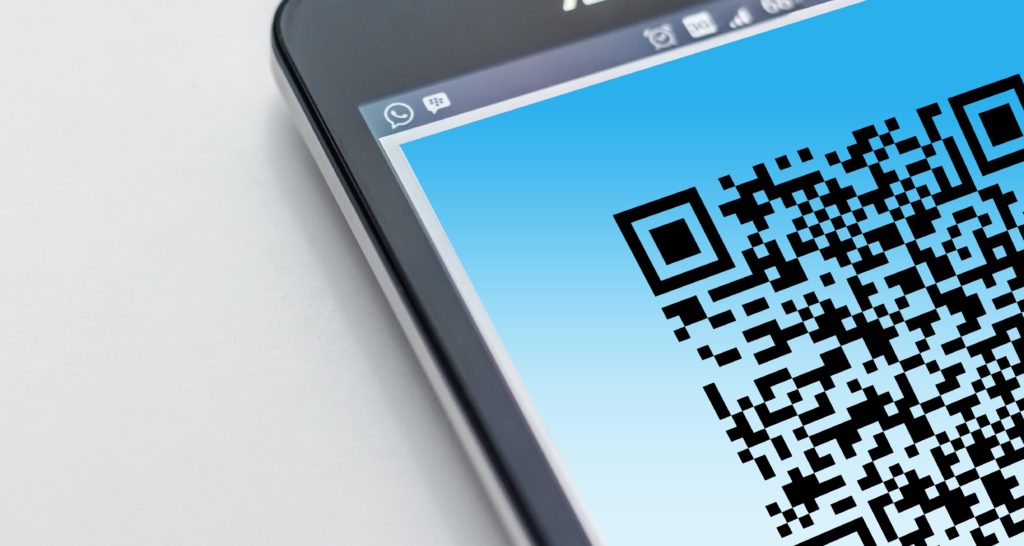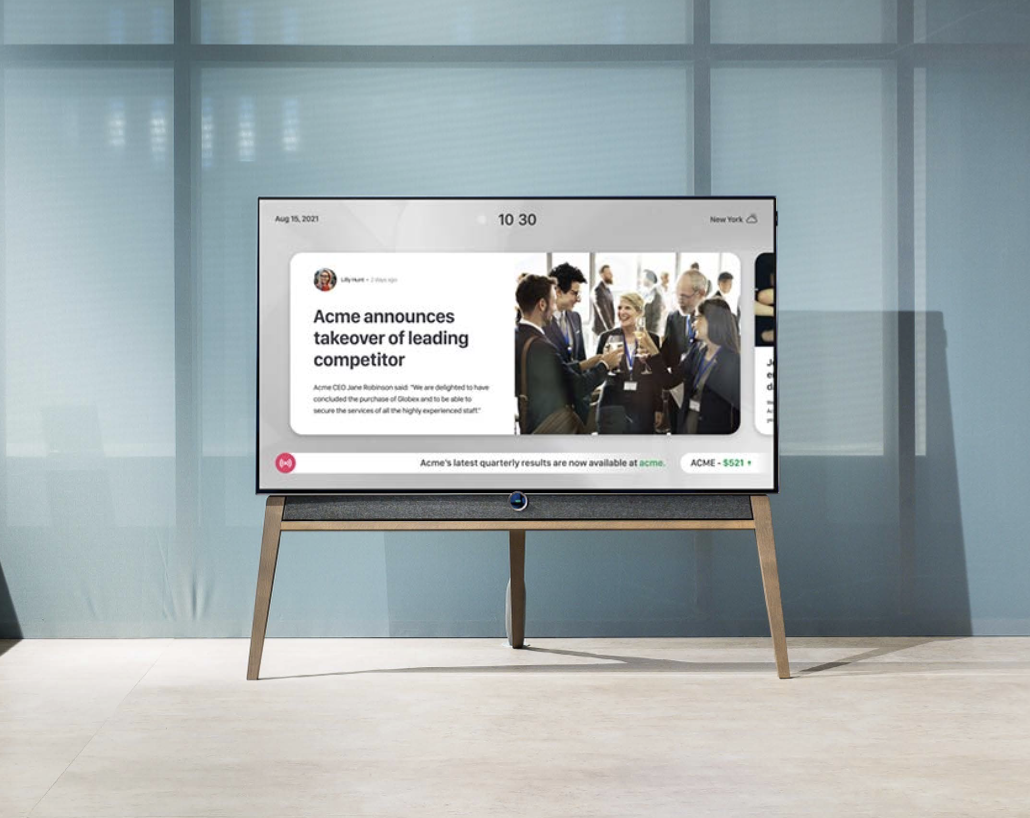To better support those communicators who know that not every employee spends all day at a desk, but that connecting everyone is critical for positive culture and employee satisfaction, we recently launched our new intranet feature, Digital Signage. Some individuals, or even entire segments of a workforce, may work offline or without instant access to a laptop or smartphone. The challenge Digital Signage helps internal communications teams overcome is reaching each of those employees, keeping them engaged, and ensuring they’re aligned with the company strategy, no matter how often things change.
“In a world where attention spans are short and time constrained, are we missing an opportunity to engage our audiences more quickly, effectively and emotionally?”
PWC, The Power of Visual Communication
Digital signage is a vital component in any multichannel communication strategy. Whether you have digital screens in your warehouse, reception area, canteen, or different global locations, digital signage on TV screens or tablets can keep everyone connected and informed, regardless of how or where they work, from deploying change and crisis comms, to driving engagement, sharing insights, and celebrating success.
Plug-and-play solutions work with existing displays, which means that very little investment is needed, but also that setting up far-reaching digital signage communications can take place easily in even the most globally dispersed organizations. But how can comms teams ensure they are using on-screen communications in a way that gets maximum engagement for their content?
What is digital signage?
The standard view of digital signage is that it’s a subset of electronic communication, allowing messages to be placed on display technologies, including TV screens, LCD and LED displays, projectors, and tablets. This has been used to excellent effect in advertising, sending out combinations of video, images, and text onto the display technologies that are now ubiquitous in daily life. Consumers now regularly see brand adverts and public information broadcasts on taxi screens, airport consoles, restaurant displays, and many more.
Obviously the displays are just one part of this process, and what’s also needed is the software that allows the content to be displayed, along with the actual content of the message itself. With an integrated intranet that offers digital signage capabilities, internal communicators can connect with employees through the same means. But to do so in an engaging way takes some knowledge of the best ways to use the technologies for good effect.
Here’s our pick of digital signage best practices that internal comms teams should consider:
Make your content clear and digestible

Having digital screens strategically placed in your locations can give your internal comms a boost, extending your reach and improving engagement, but only if the content displayed is designed to be read and digested quickly and easily. Most employees will be viewing your screens from a distance, so it’s beneficial to stick to large font types and concise sentences to help reduce the amount of text on screen. If in doubt, use the 3×5 rule which recommends using no more than three lines of text containing a maximum five words each, or five lines of text each containing no more than three words each.
Font types are another important consideration, and while it may be tempting to experiment with fun, attention-grabbing options, serif fonts should be avoided entirely as they can be difficult to read at distance. Sans-serif fonts will be much easier to digest quickly from a distance, and displaying your text in bold will help to enhance this. Italics may be great for adding emphasis in your messaging, but this too can make text harder to read, so remember that less is more and limit yourself to one or two italicized words per sentence.
It’s also wise to refrain from using more than two fonts as this can make screens seem crowded and messaging harder to digest.
The internal communicator’s digital signage handbook
Command attention with color

Color is an important element in visual communications and can make all the difference when it comes to engagement. According to research from Hubsoft, visuals with color increase people’s willingness to read content by 80%.
When it comes to text color, it can be tempting to choose bright, stand-out colors. While there’s nothing wrong with getting creative, it’s important that text color contrasts well against your background as this will ensure it is easily readable.
Don’t just message – measure too

The biggest appeal of digital signage may be its ability to extend the reach of your messaging, but it should also help to measure the impact of that messaging, as well as to understand how employees are engaging with it. This is why it’s important that your chosen solution provides the tools to measure effectiveness.
A multichannel internal communications platform that features built-in analytics will provide you with the insights you need to measure the effectiveness of messaging displayed on your screens, and understand what kind of content resonates with your people.
A multichannel platform that allows you to embed QR codes into your digital signage will provide the most accurate measurement of your comms. Not only will QR codes (some platforms also now rely on dynamic QR codes) give employees a quick and easy way to interact with the signage, by taking them to a post on your intranet that provides further information, it will also allow you to track exactly who has interacted with the message by scanning the code.
The internal communicator’s digital signage handbook
Increase content relevancy

Not all comms are relevant to everyone in your organization. Sending messages that aren’t important to every person can drown out other critical messages that do need to reach them and can leave employees feeling ‘spammed’. Creating channels for different locations is a simple way to overcome this.
Creating separate channels for your screens in your US headquarters, UK headquarters, storage facilities, warehouses, and canteens, for example, can improve the relevancy of your content by allowing you to deploy comms that are pertinent to work groups in those different locations through each channel.
With personalization becoming an increasingly important part of employee experience (EX), having separate channels also gives you the opportunity to tailor your corporate communications to different audiences in a bid to increase engagement. This can be achieved by optimizing the layout, language, and priority of content distributed down each channel.
Spread a little happiness with digital signage

Just because your screens are there to serve a serious purpose such as displaying company updates or internal PR, there’s no harm in having a little fun from time to time. In fact, injecting some humor or whimsy into your digital signage content strategy can surprise and delight your people, support a happier, more vibrant company culture, and enhance the employee experience.
There have been plenty of viral examples of comical messages broadcast on digital boards by the side of the road, or on public transport networks such as the London Underground. If a short comical poem can elicit a warm reaction from Londoners during rush hour (perhaps the world’s toughest crowd), just imagine what it could do for workplace morale. Consider mixing up your internal digital signage content with riddles, seasonal recipes, topical puns, or even photographs from recent company events.
The onus to come up with fun ideas doesn’t always have to fall on internal communicators. Why not arrange occasional employee or team takeovers where they can share anything they choose (within reason), such as poems, inspirational quotes, updates about exciting projects, or whatever they feel will brighten their co-workers’ days.
The internal communicator’s digital signage handbook
Make your Call to Action clear

Internal communications often intend to encourage employees to perform a specific action, such as read a policy or fill out a survey. Again, this is where QR codes are a vital component in digital signage: allowing employees to perform the action you want by taking them to right page on your intranet. It helps to make it clear that this is what you want the reader to do, so state this in obvious language, but remember to keep it concise.
Remove the burden from managing multichannel messaging

Managing multiple communications across different platforms can be a lot of work for comms professionals, and with a lot to keep on top of, there’s plenty that can go wrong. When it comes to deploying and managing digital signage across screens in multiple locations, using one internal comms platform that integrates all of your messaging channels can make life so much simpler.
Modern intranet software that supports multichannel messaging, including digital signage, can be the ideal internal communications platform, allowing you to trigger campaigns and ad-hoc messaging across all channels or a selection of channels quickly and easy. This removes the hassle of working across different platforms and struggling to align the timing of your comms being deployed.
Digital signage technical considerations

Communications and HR professionals may not be as tech-savvy as IT teams, so technical support may be required when it comes to managing digital signage for your intranet. However, with IT teams often putting out fires and working on other innovation projects across the business, a solution that provides offline support and automatic updates can significantly lessen the load.
A digital signage solution that promises offline support should deliver this in the form of built-in caching that will keep content visible on displays even if they happen to lose connectivity. This helps to ensure your content still reaches the right people and that important messaging and updates are not being missed.
Triggering updates that are issued by your intranet software provider ticks another checkbox on the to-do list for whichever team (comms, HR, or IT) is tasked with maintaining the platform. When updates need to be manually triggered this way, important updates that bolster security or add valuable new features can all too easily be missed. A solution that self-updates automatically will eliminate the risk of running an outdated version of the software, and ensures you’re always getting the best possible experience from your investment.
A consumer-grade solution to reach and engage every employee
With 80% of brands recording substantial increases in sales when using digital signage, it makes sense for workplaces to adapt and transform too, especially in an age when there is so much focus on digital employee experience (DEX), but not all employees are necessarily digitally connected to the organization while they work. A modern intranet with features that enable all of the best practices outlined above is the ideal tool for creating consumer-grade communications that reach and engage every employee.


